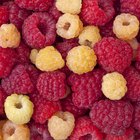goshdarnypooh/iStock/GettyImages
Fresh fruit is wonderful for eating out of hand, but using it with your baked goods can be a bit challenging. Delicate berries and soft fruits begin to deteriorate quickly once they're used to decorate your cakes or tarts, whether from browning or simply drying out as their fresh juices evaporate into the unforgiving air. Coating the fruit with a clear glaze helps preserve its natural beauty, adds a glossy sheen, and can even sometimes bring an added level of flavor.
Look In the Mirror
The fruit glaze used most often by professionals is known by the French term miroir, or mirror. The basic version starts with a simple syrup made by boiling sugar and water together, and then adds just enough gelatin to make it set. Let the mixture cool until it's just warm but still liquid, and brush it on over your fruit. You can warm it gently over boiling water or in your microwave to keep it from setting until you're finished. Leftover glaze can be refrigerated and then softened again the same way for later use, and it keeps for up to a week in the fridge.
Cornstarch Fruit Glaze Recipe
If you've ever used cornstarch to thicken a sauce, you'll know that it sets gently to a glossy sheen. That makes it suitable for use in a clear or at least "near clear" fruit glaze. Start by heating simple syrup or a clear liquid such as lemonade, apple juice, white wine or a colorless soda that's been shaken or stirred until the bubbles go away. Once it's at or near a boil, whisk cornstarch into a small amount of cold water or juice, and stir it in and boil for a few moments until the glaze thickens and sets. Brush the finished glaze over your fruit while the glaze is warm, but not hot. This glaze won't reheat well for a second use, so make it in small batches and discard it when you're done.
Color Code
If you want a fruit glaze that deepens the color and flavor of the fruit, it's quite possible to make versions of these clear glazes to do that for you. The trick is to use a juice or strained puree that matches or complements the color and flavor of your fruit. For example, orange juice or an orange-peach punch would make a yellow-gold glaze that would still look clear if it was brushed over citrus segments, peaches or pineapple. Pomegranate juice would give a tart, clear-red glaze ideal for brushing over strawberries or sweet cherries. As long as the flavors and colors go together well, these glazes are just as strong an option as the clear version.
Another Approach to Fruit Glaze
Of course, the simplest way to glaze fruit is to use what you've already got on hand. European pastry chefs have traditionally used red currant jelly as a "clear" glaze for red or purple fruits, and apricot jam for pale-colored fruits. Just heat the jelly until it's softened enough to brush onto the fruit. In the case of the apricot jam, you'll need to press it through a strainer to remove the pieces of apricot. You can use the same basic technique with any other jelly you've got: Apple jelly provides a neutral color, while a red jelly from raspberries or cranberries would look clear on red berries or fruit.
Related Articles
How to Make Glaze for Fruit on Top of a ...
How to Use Arrowroot to Thicken a Fruit ...

What Is a Good Substitute for ...

What Can I Use in Place of Powdered ...

How to Freeze Raspberries

How to Fix Grainy Whipped Ganache

How to Thicken Raspberry Jam With ...

Can I Thicken Ganache With Powdered ...

How to Glaze a Fruitcake

Can I Use Raspberry Jelly as Cake ...

How to Make Limoncello

Baking Cakes With Frozen Fruit

How to Freeze Fresh Watermelon

Substitute for Framboise Liqueur

How to Cook Agar-Agar Jam
How to Freeze Papaya

Substitutes for Egg White Brushed on ...

How to Make a Fruit Reduction

How to Make Lemonade Using Meyer Lemons

How to Decorate Cake Using Heavy ...
References
Resources
Tips
- Use lemonade instead of other fruit juices to give your fruit glaze a translucent appearance.
Writer Bio
Fred Decker is a trained chef and prolific freelance writer. In previous careers, he sold insurance and mutual funds, and was a longtime retailer. He was educated at Memorial University of Newfoundland and the Northern Alberta Institute of Technology. His articles have appeared on numerous home and garden sites including GoneOutdoors, TheNest and eHow.